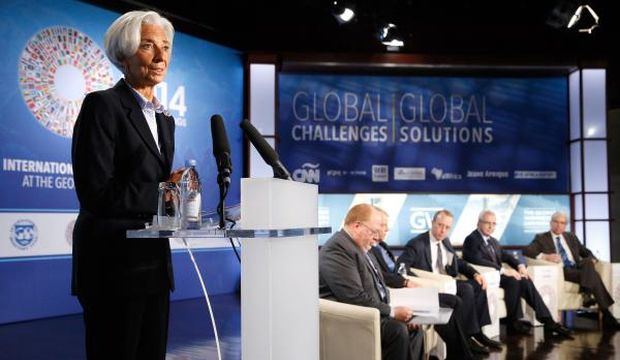
International Monetary Fund (IMF) Managing Director Christine Lagarde gives opening remarks before a session addressing inclusive growth during the World Bank and IMF annual meetings in Washington, DC, USA, on October 8, 2014. (Reuters/Jonathan Ernst)
Washington, Asharq Al-Awsat—Economic growth in the Middle East and North Africa (MENA) region is projected to average 4.2 percent in 2015, up from 3.5 percent this year, the World Bank said in a report published on Wednesday, as representatives from across the globe gather in Washington for the IMF and World Bank’s annual meetings.
The World Bank said violent conflicts in the region in countries such as Syria, Iraq, Gaza, Yemen and Libya, as well as their spillover effects into neighboring countries like Lebanon and Jordan, were seriously hampering regional growth.
But the report also said the region’s “young, educated population, strategic location and natural resources” meant it possessed “huge potential” for achieving prosperity.
“Domestic consumption, easing political tensions which could improve investors’ confidence in Egypt and Tunisia, and full resumption of oil production in Libya” could all help push up collective regional growth to 5.2 percent, it said.
In terms of individual economies, those of “transition countries” such as Egypt and Tunisia are projected to grow by 3.1 and 2.7 percent respectively, while countries in the Gulf can expect to grow on average by 5 percent.
But despite the improved growth outlook for 2015, conflicts in Syria and Iraq, and the July–August war in Gaza and “ongoing insurgencies in Yemen,” would seriously slow growth in these countries. The world needed to come together to help the region “and support a turnaround, much as it did in 1944 when Europe was mired in conflict,” it said.
The perennial issue of energy subsidies was singled out as being particularly corrosive to regional economies, with the report saying antiquated subsidy systems in many countries in the region had severely restricted competition and contributed to high unemployment rates.
Egypt and Tunisia have recently slashed subsidies on food and fuel products, but Yemen rescinded a decision to cancel subsidies this month following widespread protests in the capital Sana’a.
This comes as representatives from around the world gather in Washington this week for the IMF and World Bank annual meetings, scheduled to run until October 12.
The meetings will focus this year on the widening wealth gap between rich and poor around the globe and ways to bridge it, highlighting an initiative by both institutions vowing to virtually eradicate poverty by 2030.
Speaking at an event on Wednesday prior to the launch of the meetings, World Bank President Jim Yong Kim said: “We are working to ensure that the growth of the global economy will improve the lives of all members of society not only a fortunate few . . . To accomplish this, the World Bank Group aims to achieve specific income-related and social goals: We want to raise the earnings of the lowest 40 percent of income earners in developing countries and improve their access to life’s essentials, including food, healthcare, education and jobs.”
It is estimated that some 1 billion people—14 percent of the world’s total population—are currently living below the poverty line of 1.25 US dollars per day. The World Bank says inequality has now reached “levels unprecedented since the Second World War,” with the richest 10 percent of the world’s population earning 9.5 times more than the poorest 10 percent, up from 7 times more 25 years ago.
